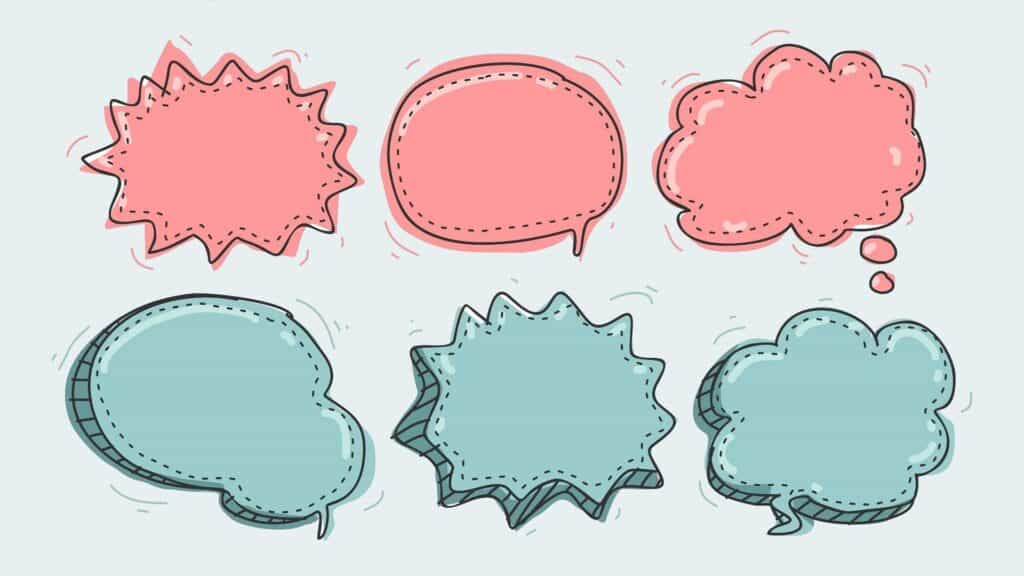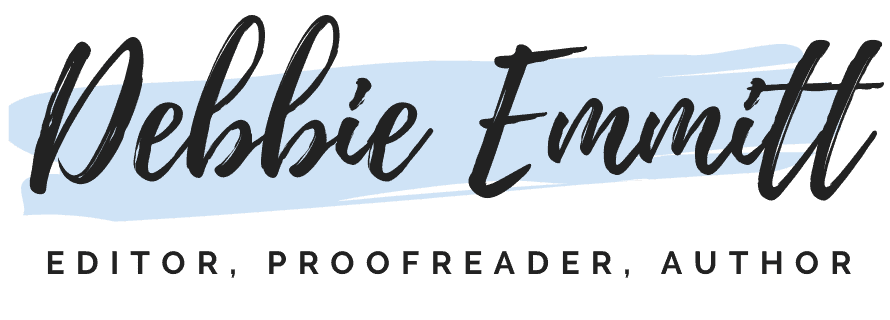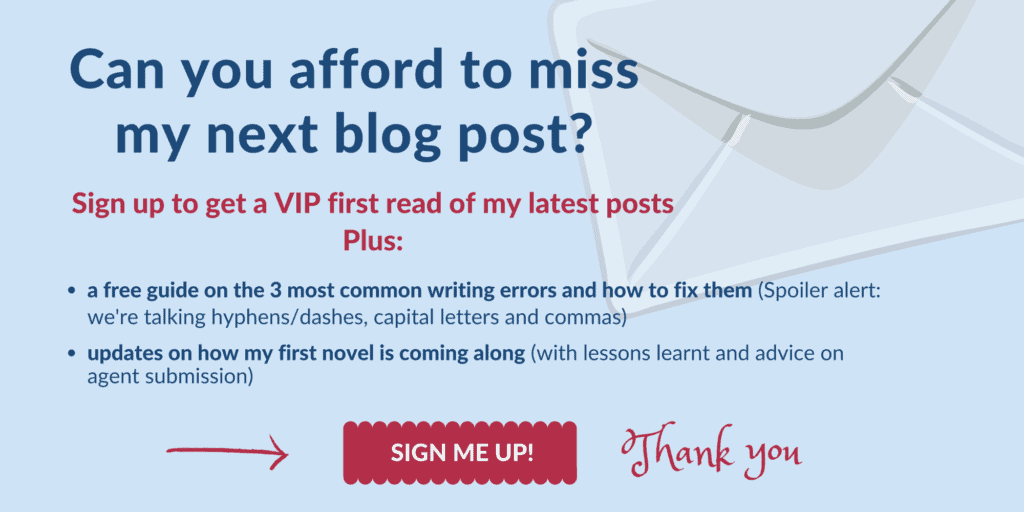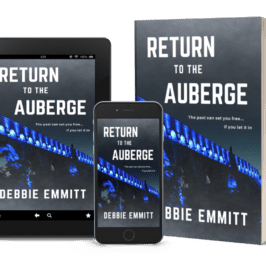
You may have a solid understanding of punctuation, but punctuating dialogue is a whole other skill set! Follow my in-depth guide on how to punctuate and format dialogue, including common errors.
I’m on the judging panel for Writing Battle (it’s a fantastic contest, with no AI feedback in sight!) It’s an honour to read so many well-crafted stories, and I’m in awe of every author putting themselves out there for their writing to be judged.
With my copyediting hat on, I’ve noticed similar issues repeatedly crop up during the contest regarding dialogue punctuation. This got me thinking that my fellow authors may welcome a reminder of this tricky area. I say ‘tricky’, because some of it is definitely counter-intuitive!
Let’s jump in!
Speech marks in dialogue
Speech marks, also known as inverted commas, quotation marks or quotes, enclose the words uttered by a character. Simple, yes? Well, not necessarily.
Double or single speech marks?
Depending on which style guide you’re following (which may be largely dictated by your location or that of your target readers), you’ll use either double or single quotes.
Broadly speaking, single speech marks are more commonly seen in books produced in the UK, and doubles in the US, although this isn’t a hard and fast rule.
I’ve always found this odd. I was born and raised in the UK, and I remember my English teacher, Mrs Belcher, drumming into us the rules of dialogue punctuation. We always used doubles! So, I’m not sure why the publishing convention in the UK doesn’t match that, but it doesn’t.
Children’s books, however, seem to use double speech marks more often than singles, even in the UK (at least, those on my bookshelves at home certainly do). I can’t find a rule dictating this, so if you can point me in the direction of a resource that confirms this, do let me know in the comments!
Placement of speech marks
Speech marks go around the words spoken by a character, also including any final punctuation.
- “I can’t do this any longer,” she said.
- He stared at me. “What’s that on your nose?”
Nested speech marks
If a character is speaking, and they quote another person, or if you need to use scare quotes within the dialogue, use the alternate style of quotes to that which you’re using as a default.
In other words, if you’re using double speech marks as a rule, employ singles for the quotes within quotes. If you’re using single quotes by default, switch to doubles for nested quotes.
For example:
- “I can’t believe what he said to me. ‘Get lost!’ Do you really think that’s reasonable?” (singles within doubles)
- ‘It’s what you might call a “sticky” situation,’ she said gleefully. ‘Get it? You’ve stepped in a blob of honey. “Sticky” situation? Oh, never mind.’ (doubles within singles)
Monologues over multiple paragraphs
Sometimes, the same character is speaking when one paragraph ends and a new paragraph begins. If no action or dialogue tag is in sight, don’t close the preceding paragraph with speech marks, just use opening speech marks at the start of the next paragraph.
For example:
“I’ll tell you what happened. First of all, [start of a long monologue] blah blah.
“Then, would you believe, this other really interesting thing happened [continuation of the long monologue] blah blah.
“Finally, we decided to get out of there and have some coffee and cake.”
Action tags
Action tags tell your readers what your characters are doing before, during or after their speech. They are different from dialogue tags (which we’ll get on to in a minute) because they aren’t synonyms of ‘to say’.
Punctuation and formatting of action tags
Action tags are punctuated differently from dialogue tags. I’ll say that once more for the people at the back: Action tags are punctuated differently from dialogue tags.
When an action tag follows speech, the character’s words end with a full stop/period (or exclamation mark or question mark, or an ellipsis or em dash if trailing off or interrupted), NOT a comma. The action tag then begins with a capital letter, as it’s the start of a new sentence.
When an action tag precedes speech, the tag ends in a full stop/period.
For example:
- “I think I love you.” He scratched his chin awkwardly.
- “Don’t you dare!” She took a step towards me.
- She jumped into the water. “Come on! It’s not cold!”
Common action tag errors
The two most common action tag errors I see when editing are:
- Using a comma rather than a full stop/period at the end of an action tag that precedes the speech, or at the end of the speech before the action tag.
- Using a lowercase letter for the action tag following the character’s speech.
Here’s an example of incorrect use of a comma before an action tag and lower case for an action tag: “I don’t believe you,” he shrugged. ‘Shrugged’ is an action, not a synonym of ‘said’.
Dialogue tags
Also known as speech tags, dialogue tags use the verb ‘to say’ and synonyms thereof (e.g. replied, exclaimed, shouted).
Punctuation and formatting of dialogue tags
If a dialogue tag comes after a character’s speech, don’t put a full stop or period before the closing speech mark. Use a comma, question mark or exclamation mark.
If a dialogue tag precedes the speech, use a comma before the opening speech mark. The first word after the opening speech mark begins with a capital letter.
Incorrect capitalisation of dialogue tags is one of the most common dialogue errors I see in my editing work. Dialogue tags should always be lower case when following dialogue, even after exclamation marks and question marks, as the tag is still part of the same sentence.
For example:
- “I’m almost thirty-two,” she said.
- “Are you coming?” he called.
- Mark shouted, “Get a move on!”
When is a dialogue tag not a dialogue tag?
When it’s an action tag. Okay, I’m going off on a tangent here, as this isn’t to do with punctuating dialogue. However, I see this error all the time when editing and proofreading, so I wanted to include it here.
Certain tags may look like a dialogue tag, but they aren’t synonyms of ‘to say’. To work out if you’ve used an action tag in place of a dialogue tag, say your character’s words out loud, using the dialogue tag. Can you speak while doing the action? If not, then either punctuate your chosen tag as an action tag, or pick another verb.
Is ‘laugh’ a dialogue tag?
No. It may look like a dialogue tag, but think about it. You can’t laugh a sentence. You might start with a laugh, or giggle halfway through, but you certainly wouldn’t laugh more than one or two words in a row. You’d sound ridiculous.
Is ‘hiss’ a dialogue tag?
There is some debate over whether or not ‘hiss’ can be used as a dialogue tag. Some quarters say NEVER! Others think it’s okay, as long as the words uttered include an ‘ss’ sound.
Common dialogue tag errors
The three most common dialogue tag errors I see when editing are:
- Using an action tag as a dialogue tag. Only use synonyms of ‘to say’ as a dialogue tag.
- Using a full stop/period rather than a comma to end the speech before the dialogue tag.
- Using a capital letter for a dialogue tag following speech.
Here’s an example of incorrect use of a full stop/period before a dialogue tag and upper case for a dialogue tag: “I don’t believe you.” He said.
Interrupted dialogue and trailing off
If a character’s speech is halted for some reason, there’s a particular way to show this. The correct punctuation differs depending on whether it is a true interruption or more of a trailing off.
Interrupted dialogue
There are different reasons for using interrupted dialogue in writing. Your character may be speaking when someone else jumps in. Or, an event could cut them off mid-speech. They may even interrupt themselves.
All these instances of interruption use the same punctuation: an unspaced em dash before the closing speech mark.
For example:
- “You’re the last person in the world I wan—”
“I don’t care what you think!” - “You’re not going out dressed like that, young la—”
The door slammed.
If you want to interrupt dialogue midstream by an action beat, use either an unspaced em dash or a spaced en dash, depending on which style guide you’re following. As a broad guide, US English tends to favour the unspaced em dash and UK English prefers the spaced en dash.
For example:
- “Did the wedding go okay? Was it” – John leaned back in an artificially relaxed pose – “special?” (spaced en dash)
- “That’s the last time” – he poked Alfie’s chest – “you see that woman.” (spaced en dash)
- “But I don’t want to go”—Molly sniffed—”without you.” (unspaced em dash)
- “That was so”—she punched the air—”exhilarating!” (unspaced em dash)
Louise Harnby’s post on how to punctuate dialogue broken midstream by an action beat covers this in more detail. She includes examples in British and US English.
Lyss Em’s article on interrupted dialogue is an in-depth resource for all kinds of interrupted dialogue for authors using Chicago (CMOS) style.
Trailing off
Trailing off is a form of interruption, but it’s more gentle than the examples already mentioned. It tends to show that it’s the character’s choice to stop talking, rather than them being forced to stop by someone or something.
For example:
- “I suppose you could …” She furrowed her brow.
- “Let’s head over the ridge, and …” He looked at the sky.
It isn’t necessary (or desirable) to include trailing-off information in the dialogue tag that follows. Don’t follow the ellipsis and closing speech mark with “she trailed off” or “his voice died away”. This would be saying the same thing twice and smacks of telling rather than showing.
The styling of the ellipses depends on which style guide you’re following. For an in-depth look at ellipses and whether or not to include a space before or after, or between the dots, see my full guide to using ellipses.
Over to you
What other elements of punctuating dialogue do you struggle with? Or are there other pieces of wisdom you’d like to see added to this article?
Let me know in the comments!









Rali Chorbadzhiyska
What a helpful article, thank you! I’m currently proofreading a novel told in the first person perspective, and sometimes the narrative quotes what other characters have said [i.e. My mother always called us her ‘golden girls’.] Interestingly, however, the typesetting sometimes includes a speech mark within the quotation marks if it’s in the middle of the sentence [i.e. My mother always called us her ‘golden girls,’ and we never challenged her on it.] To me, the comma belongs to the sentence, not the quotation. What is your take on it?
Debbie Emmitt
Hi Rali, I’m glad you found the article useful!
Regarding your question, the placement of punctuation either inside or outside quotes within quotes or scare quotes is a style choice.
Generally speaking, if you’re editing in British English, the punctuation goes outside the quotes (‘golden girls’,). In US English, the preference is to include commas or full stops/periods inside the quotes, even if the punctuation isn’t part of the quoted text (‘golden girls,’). The latter approach always seems rather illogical to me, but that’s the convention.
Either way, the method chosen should be consistent through the manuscript.
I hope this helps!
Kelly Caine
Thank you, Debbie—this is another fantastic resource!
I recently worked with a client who needed significant help with their speech dialogue, and this resource would have been incredibly valuable for them. Would it be okay if I shared this with future clients who might benefit from it?
Debbie Emmitt
Hi Kelly, so pleased you found it useful! Of course you can share the link with anyone who may benefit from the article; please do!
Layla Campos
Hello Debbie,
I recently joined a writing club to improve my skills. I’m only ten years old and don’t expect to become a published writer; I just enjoy writing. But after writing a story, the “instructor” made several punctuation corrections to my dialogue.
He told me that this is the preferred way to punctuate dialogue when an action briefly interrupts a character’s speech: “Mary,” Ann rushed to cover her sister’s mouth. “Don’t say his name. Father will have your tongue cut out.”
But everywhere I read, including your blog, it says to do:
“Mary”—Ann rushed to cover her sister’s mouth—“Don’t say his name. Father will have your tongue cut out.”
or
“Mary.” Ann rushed to cover her sister’s mouth. “Don’t say his name. Father will have your tongue cut out.” (The second example is to avoid overusing em-dashes.)
I am a bit confused, so I thought that maybe you as a proofreader and editor, could clear this up for me.
Thank you.
Debbie Emmitt
Hi Layla, thanks for your comment. It’s a great move to join a writing club! You’ll learn loads from the other writers and will develop a regular writing habit. You’re also starting young, so you have plenty of time to polish your writing skills (although, going by your post here, it’s clear you already have excellent spelling, grammar and punctuation skills!).
In answer to your question, you are completely correct! There are two ways to correctly punctuate your example, depending on whether Ann is rushing to cover her sister’s mouth at the same time as speaking or not. Using em (long) dashes, as you have done in your first example, is the right way to show either interrupted dialogue or action occurring at the same time as the dialogue.
If you want to show that she said “Mary,” then rushed to cover her sister’s mouth, then carried on speaking, your second example is better (maybe even using an exclamation mark after Mary): “Mary!” Ann rushed to cover her sister’s mouth. “Don’t say his name. Father will have your tongue cut out.”
Your instructor is mistaken that a comma is correct here, as an action tag is following “Mary”, not a dialogue tag. A comma would be correct in the following example, as there is a dialogue tag: “Mary,” Ann said.
In summary, your instincts are 100% correct. Good luck with your writing, and if you have any more grammar or punctuation questions, feel free to ask!